

The Hawaiian, 1969-71
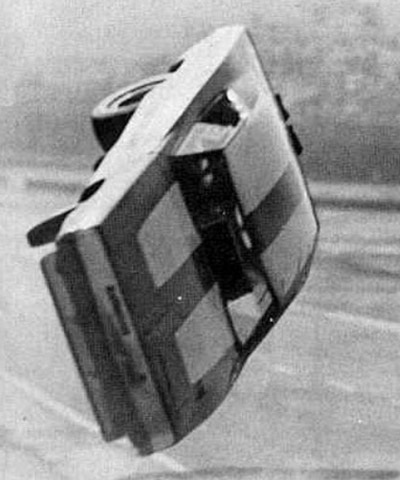
National Dragster's Lane Evans captured this unforgettable image of the flying Hawaiian. There are no subsequent shots from him because it was the last exposure on his roll of film (but we have more angles below).
Last week’s recounting of Clare Sanders’ Funny Car victory at the 1969 Winternationals included, of course, mention of the event’s most spectacular moment, the Hawaiian Charger and driver Larry Reyes taking off kite-like at the finish line in round one, and I got a lot of requests for more information about what was truly an iconic Winternationals moment, captured by National Dragster Managing Editor Lane Evans at the height of its flight.
I’ve written about the incident in this column in a piece about Reyes’ career, but it has been a number of years since then; newer readers might not have seen it, and older readers might not remember it, and it’s certainly well worth revisiting as we look back at the history of the Funny Car. Although, as we have learned, Funny Cars had been around for several years before the 1969 season, that year may have signaled a changing of the guard as fuel dragster stalwarts such as Leong jumped ship to the still-fledgling class.
I’m blessed to count Leong as one of my good friends among the old guard. He has always been very friendly, welcoming, and grateful for my interest in his career. That we share the same birthday (May 22) and that he lives in Southern California just a few miles from where I grew up probably forever seals our friendship. I was happy to see Leong at this year’s Circle K NHRA Winternationals and chatted briefly with him about his great Winternationals history (which included an interesting three-peat: a Top Gas win with Danny Ongais in 1964 and Top Fuel wins in 1965 and 1966 with Don Prudhomme and Mike Snively, respectively) and about how he rebounded from that 1969 disaster to win the Winternationals Funny Car title the next two years – in 1970 with Reyes and in 1971 with the late Butch Maas – then followed up with him earlier this week to get the full story about his transition to Funny Car to contribute to our ongoing history lessons about the class before we move into the 1970s.

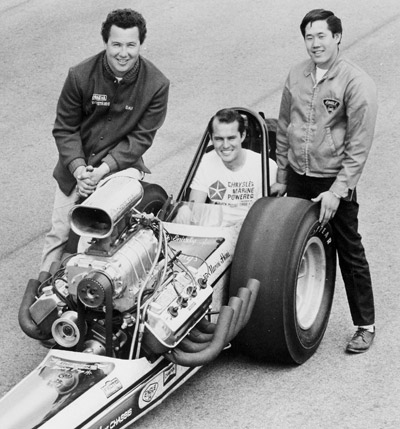
Roland Leong, right, with driver Mike Snively and Danny "Buzz" Broussard.
Leong had always been a dragster guy, running his own gas dragster in his native Hawaii before transitioning Stateside to continue his drag racing career and getting work at the Dragmaster race car emporium.
We all know what happened next. He got a Top Fuel dragster from Kent Fuller in late 1964 and crashed it on one of his first runs, hired Prudhomme to drive, and together they won the 1965 Winternationals and U.S. Nationals and never looked back.
Prudhomme ventured out on his own in 1966, so Leong hired Snively, whom he had met at the Dragmaster shop a few years earlier, and amazingly repeated the Hawaiian’s 1965 season, again winning in Pomona and Indy, and continued to win major events such as the March Meet and the Hot Rod Magazine Championship Drags in Riverside, Calif., in the next two seasons, but the handwriting was on the wall when it came to finances.
“When the Funny Cars first came out with those crazy altered wheelbases, to us dragster guys, they weren’t ‘real’ race cars, and they weren’t running at the national events, but when Mike and I were touring back East in 1968, I could see that the Funny Car guys were getting a lot more dates than we did,” he said. “We had dates, but it just seemed like the Funny Cars had become a lot more popular and began looking like real cars. I think I was one of the first of the dragster guys to switch to Funny Car.”
Even though Leong already had a dragster for the 1969 season almost complete at Don Long’s shop, he decided in October to switch classes. He called Logghe for a chassis and had his car shortly before the Winternationals. His long association with Chrysler as his engine of choice earned him a new Dodge Charger body to go atop the framerails. Now all he needed was a driver.
By late 1968, the relationship between Leong and Snively had deteriorated to the point they couldn’t continue anyway. When word got out that Leong was building a flopper, drivers wasted no time beating down his door (a frequent occurrence throughout his long career and numerous driver changes).
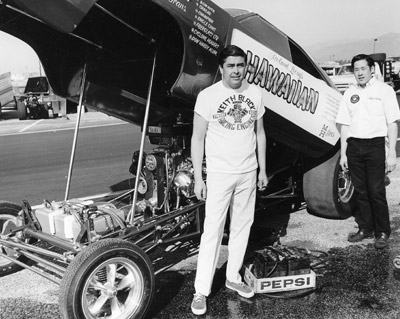
Larry Reyes and Leong and the first Hawaiian Funny Car.
Enter Larry Reyes.
Reyes had grown up in California and raced at the fabled Santa Ana Drags as early as 1955 but had moved back East to drive the Memphis, Tenn.-based Kingfish Barracuda Funny Car of Larry Coleman and Bill Taylor in 1967. After the Kingfish car and name were sold to T.B. Smallwood, Coleman, Taylor, and Reyes partnered again to run the successful Super Cuda in 1968. Reyes also had his own car at the time, which was creating some conflict with his good friend Taylor. In fact, Reyes was in Southern California, at Keith Black's shop in South Gate, Calif., getting parts for his own car when he ran into Leong.
"I knew who Roland was and had seen him race but had never actually met him," recalled Reyes. "He came up and introduced himself to me. He told me that he was building a Funny Car, which I already knew because everyone wanted to drive it. He said, 'I was wondering if you'd be interested in driving it.' I told him that I had a ride already, but I would think about it. He called me a week or two later and asked me if I'd thought about it, and I decided to do it. I heard later that Gene Snow had recommended me to Roland, but there were a lot of guys who were good-naturedly mad at me, guys like Steve Bovan who told me they'd turned in résumés to Roland and everything."
At first, longtime dragster guy Leong could only shake his head at his new race car.
“It had a fuel motor, but I didn’t know anything about automatic transmissions, and the whole car was sprung with traction bars and shocks and had wheelie bars and all kinds of [stuff] us dragster guys had never seen before. I knew how to make power, and Reyes had some experience with automatic transmissions, so we figured it out."
With just a few shakedown runs, the team headed to Pomona for the 1969 season-opening Winternationals, but Reyes already has misgivings.
"As soon as I got into that car, I didn't like it," he told me. "The braking system didn’t work; it wouldn’t steer or turn. At Pomona, I had to stage in high gear because I couldn't hold the car on the line in low. I said to myself, 'What have I done?' The car was too big, and I couldn't see out of it. I remember sitting on the starting line, ready to stage, with the car idling, yanking the belts tight, and saying, 'Lord, please don’t let me hurt anyone.' "
Launching in high gear cost e.t., plus the car was a spooky handler during his qualifying runs, forcing Reyes to lift early and pull the chute, but he nonetheless gutted it out and made the field on the bump spot with an off-pace 8.33; by contrast, Tom McEwen was at the head of the pack with a 7.79.
Reyes drew Mike Hamby in round one and had just turned on the win light, 8.14, 181.45 to 8.58, 167.91, when things went really bad.
The car got loose in the lights, and the rear end came around. Reyes had avoided a nearly similar incident in qualifying by quickly deploying the chute, but this time, there was no saving the car. It swapped ends and became airborne and flew an estimated 200 feet through the Pomona shutdown area. It landed on its lid, slid for a moment on its roof, then rolled a half-roll and landed on all four wheels, chucking the body in the process. Reyes emerged unhurt.
Looking back, it’s easy now for Leong to see what the problem was.
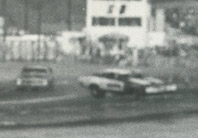 |
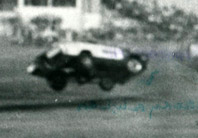 |
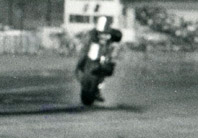 |
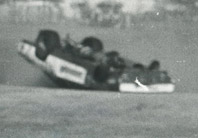 |
| I had never seen this sequence before, shot by George Lee. | |
“I admit that I didn’t even really know much about the bodies; all I knew was that guys like [Don] Nicholson who had those first Mercurys, the bodies flew because wind got under the front end, so guys started putting what they called a scoop on the front end to keep the wind out,” he said. “I remember that after we got our first body, I called the guys at Chrysler and asked them if we needed a real spoiler, too, and they told me that they were just running a stock spoiler on their NASCAR bodies, and that would be all we needed. [The cars were running about the same speed; the pole position for that year’s Daytona 500 was won at 188 mph.] What they didn’t take into account was that their stock cars weighed twice as much as our Funny Car and sat lower to the ground. It’s no surprise that the ass end got loose and the car flew.”
Logghe’s Jay Howell was at the race, so Leong immediately commissioned a replacement, and, thinking that the bulky Charger body might be the problem, he rebuilt with what was known then as a “mini Charger” body, some 6 inches narrower, 16 inches shorter, and, just as important, 2 inches lower, built by Ron Pellegrini at his famed Fiberglass Ltd. shop.
(The 1969 Long dragster chassis that Leong had ordered did not go to waste; Prudhomme bought it from Leong, and it became the Wynn’s Winder. While Leong was waiting for the Funny Car to be repaired, he tuned on Prudhomme’s car and won the National Open at Stardust Int’l Raceway in Las Vegas.)
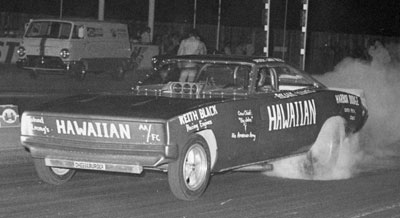
(Above) The Hawaiian rebounded from its Pomona crash to win three races over Memorial Day weekend. (Below) From right, Leong, Reyes, OCIR track manager Mike Jones, Keith Black, and John Mazmanian.
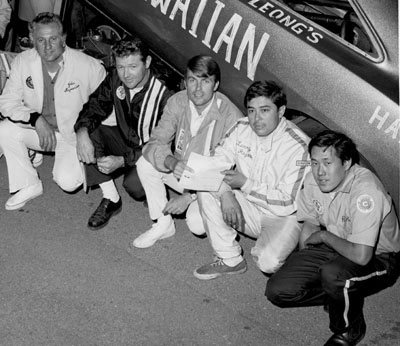
In late May, Reyes made the long trip back to Michigan to fetch the new car and towed it back to Southern California, where Leong couldn’t wait to get the new piece on the track, and their Memorial Day weekend comeback could not have been more spectacular. With shoe-polish lettering personally (and quite neatly) applied by Leong, the new Hawaiian won three times in its comeback.
"We had a match race at Irwindale against the Freight Train [Top Gas dragster] on Friday night and won that,” Leong recalls. “On Saturday night, we won the Hang 10 500 at Orange County – and got the $500 for low e.t. of every round – and on Sunday, we went to Carlsbad and won that, too. I think we won something like $8,000 to $10,000.”
“That was a big achievement for anyone, and that money meant a lot to us,” said Reyes. “Roland told me, 'Man, you saved us,' because we were hurting for money, and I told him, 'No, we helped ourselves.' We won a lot of races with that car."
Leong had sold his 1968 Hawaiian dragster to Texas-based Jackie Peebles, who ran a chrome plating shop. As an additional thanks for the car, Peebles invited Leong to have the parts on his newly painted Hawaiian tricked out, and Leong accepted. With the car now show-worthy, Leong and Reyes headed out on a successful match race tour.
Leong and Reyes did not run any more national events that season, but when Indy rolled around, Prudhomme reached out to his old friend for help. Leong couldn’t resist but already had his car booked for three days at Great Lakes Dragaway, so he sent Reyes by himself, telling him, “Put 85 percent [nitro] in it and don’t mess with it.”
Reyes won all three days at Great Lakes, and Leong and Prudhomme won Indy again together (as they would again in 1970). All things considered, an amazing weekend.
“At the time, I didn’t really realize how good of a driver Larry really was,” said Leong. “We didn’t have any slipper clutch or any of that [BS] back then, so getting the car down those match race tracks was tough. I have to give him a lot of credit for the races we won. He was as responsible for our success as I was.”
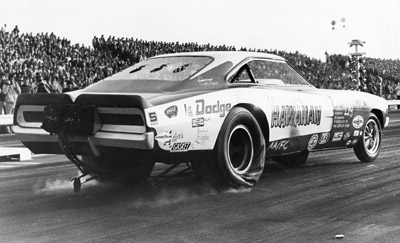
(Above) Leong and Reyes won the 1970 Winternationals together. (Below) Reyes, far lane, spotted Leonard Hughes a big advantage in the 1970 Gatornationals final and would have caught him if he hadn't shut off.
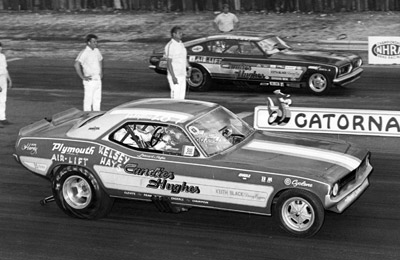
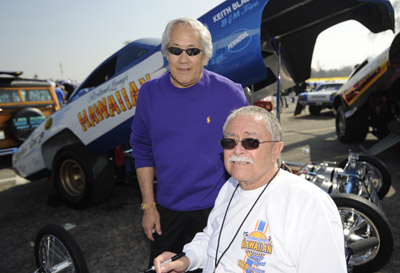
Leong and Reyes remained good friends long after they parted ways and got together 40 years later for this shot at the 2010 Winternationals.
One of the many races they won together was the 1970 Winternationals, in their return to Pomona a year after the terrifying top-end tumble. Dick Bourgeois led qualifying with a 7.53 in Don Cook’s Chevy; by contrast, the Hawaiian was down in the No. 14 spot with a 7.73. Leong and Reyes stepped up to a 7.54 in round one to beat Rich Siroonian in John Mazmanian’s 'Cuda, then advanced to the final round on red-lights by Kelly Chadwick and Leonard Hughes.
Snow, who would win three of seven events that season, as well as the world championship, was heavily favored over the Hawaiian based on his low e.t. blast of 7.30 in the semifinals but slowed to a 7.83 in the final. Reyes got out on him at the green and held on for the win with a 7.67.
Leong did not plan on racing at the Gatornationals but agreed to run a second car for Candies & Hughes at the event, which led to the first all-team final. Hughes, in the team’s new car, "beat" Reyes, in the team's battle-tested '69 car, on a holeshot, 7.29 to 7.12, in a race that was decided before the two cars staged.
"In the staging lanes before the final, they told me I had to let the new car win because they had a sponsorship coming if the new car would win,” confirmed Reyes. “I hated doing it, but I sat on the starting line when he left, ran it hard, then shut it off early. The car would have probably run a 6.95. Paul Candies told me later that he regretted doing that because that car could have been the first one to run in the sixes that day.”
Reyes stayed with Leong until just before the 1970 Nationals, when they parted company and Pat Foster took over.
"I just didn’t like traveling," admitted Reyes. "Roland kind of wanted to go a different way, and there were no hard feelings; still aren't. He's been a good friend over the years. I had a good time and learned a lot. If I had to do it over again, I might have stayed longer.” Reyes’ driving career ended in June 1971 when he was paralyzed in a racing accident after reuniting with Coleman and Taylor on the Super Cuda.
Foster finished the season for Leong, then was replaced by Maas for 1971. Maas had been introduced by Leong to Prudhomme and drove Prudhomme’s Top Fueler at the 1970 Supernationals and actually earned his Funny Car license in Prudhomme’s Hot Wheels ’Cuda (becoming one of the few guys to drive Prudhomme’s cars while he was still driving), so they were all well acquainted.
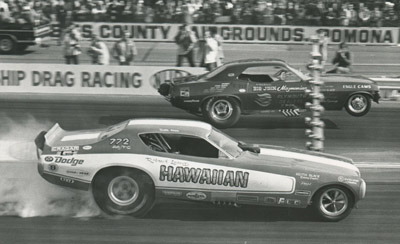
Leong also won the 1971 Winternationals with driver Butch Maas, but they were lucky to escape this tire-smoking run in round two against Rich Siroonian before they ended up in the Pomona winner's circle.
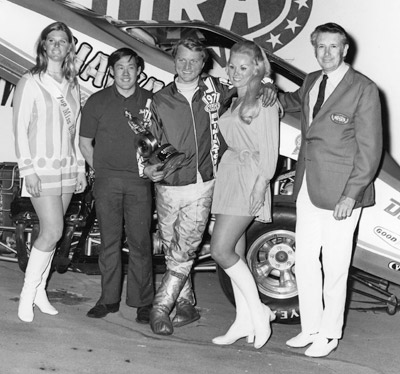
A new Logghe car was ordered – the first of the narrow-chassis, Top Fuel roll-cage designs – and carried Leong and Maas to victory at the 1971 Winternationals, with a fair bit of breaks along the way. Reyes qualified No. 5 with a 7.12, behind teammates Jake Johnston (6.94) and Snow (7.10), Richard Tharp in the Blue Max (7.11), and Reyes, now driving for Mazmanian in his brand-new Barracuda (7.12).
After an easy 7.17 to 8.06 victory over “the Action Man,” Kenney Goodell, Maas lined up against Siroonian, in Mazmanian’s ’70 entry, in round two but blazed the tires at the green. Fortunately for Leong and Maas, Siroonian’s car launched into a 2-foot wheelstand, forcing him to pedal. The candy 'Cuda touched down, and, seeing the Hawaiian’s plight, Siroonian nailed the gas again and went into an even bigger wheelie. Maas recovered traction and streaked by for a 7.26 win.
Maas was slated to face No. 2 qualifier Snow in the semifinals, but Snow had shelled the rear end during his second-round win and had given the team’s only spare to Johnston, who had suffered similar breakage in his first-round win. Without a spare, Snow had to sit out, giving Maas a freebie into the final.
Waiting in the final was Leroy Goldstein and the vaunted Ramchargers Dodge, which had run 7.09 in beating Johnston in the semifinals. Knowing that they had their work cut out for them, Leong poured the coals to the car, which responded with a stunning low e.t. of the meet run, 6.93, that allowed Maas to drive around Goldstein’s 7.08 holeshot bid.
Maas continued to drive for Leong but received second-degree burns in a match race fire in Cincinnati in late spring and headed home to recover while Leong began work on a new car. With Maas still on the mend, Leong hired Bobby Rowe to drive for the remainder of the year. Rowe left to drive for Don Schumacher in 1972 and was replaced by Leroy Chadderton (in the first Revell-backed Hawaiian, a beautiful John Buttera-built Dodge Charger).
Chadderton drove for Leong through June 1973, when the entire rig was stolen from the parking lot of a Holiday Inn in Gary, Ind., and was replaced by Canadian wunderkind Gordie Bonin, who totaled the body with an off-track excursion in Detroit in his second outing with the Hawaiian. Bonin stayed the year, then left to rejoin his former teammates Ron Hodgson and Gordon Jenner for 1974. Leong hired “Mighty Mike” Van Sant for a short stint and replaced him with Denny Savage, whose last ride in the car came in a ball of fire at that year’s Supernationals in Ontario, Calif.
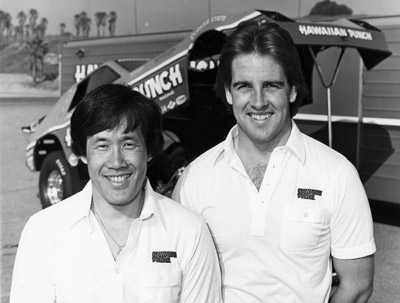
Roland Leong has had dozens of drivers in his career, including Mike Dunn (above), who drove for him 1981-84, and Jim White (below), who with Leong won the U.S. Nationals in 1991, where they were congratulated by NHRA founder Wally Parks.
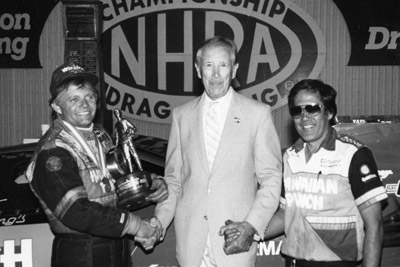
Norm Wilcox filled the Hawaiian’s cockpit in 1975, and Larry Arnold took over in 1976 before leaving midyear to start his own crankshaft company. Ron Colson enjoyed the longest tenure of any of Leong’s drivers, from mid-1976 through the end of the 1980 season, when he retired after an impressive third-place finish. Mike Dunn, who had served as a crewmember on the car since 1977, took over in 1981, with a car sponsored by Hawaiian Punch. They survived a number of calamities together in 1983 – including a trip into the Columbus catch net and his infamous barrel roll at the World Finals at OCIR – but Dunn was injured in the car in the summer of 1984 when the car broke the rear end during a match race in Kansas City, Mo. The coupler shattered and pierced his left leg and broke the bone.
Leong hired Rick Johnson to finish the season and stayed with him into 1985, when they won Le Grandnational and finished a Leong-career-high second in points that year behind only Kenny Bernstein.
Johnny West saddled up for 1986 and drove the car for three seasons, scoring a pair of runner-ups and three top-10 finishes. Jim White took over in 1989 and also raced three seasons for Leong, but with much greater success, including another Indy win in 1991 (a weekend that also included a victory in the Big Bud Shootout) and three other victories and three runner-ups. They finished second in 1991, which was the last year for the Hawaiian Punch sponsorship because the company was sold. After sitting out 1992, Leong signed a three-year deal with the Hawaiian tourism board beginning in 1993 and hired old pal Bonin back into the seat, but things quickly turned sour.
“The bottom line is that one of the politicians lied to me,” said Leong. “He gave us just enough money to get in trouble, so to speak, and told me he’d get us the money for the rest of the year later, and it turned out he never had any intentions of doing that. That was the end of my time as a car owner.”
Leong went on to become a tuner for hire and won the Winternationals again, in 1998 with Ron Capps driving Prudhomme’s car, and has since become the go-to tuner for the nostalgia Funny Car ranks, where he continues a winning legacy that started five decades ago.



















































